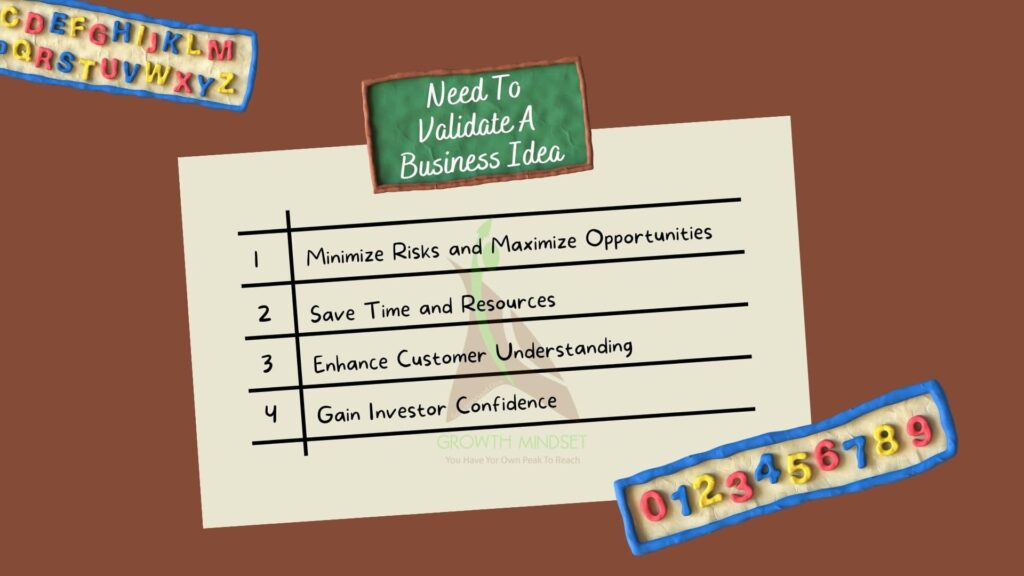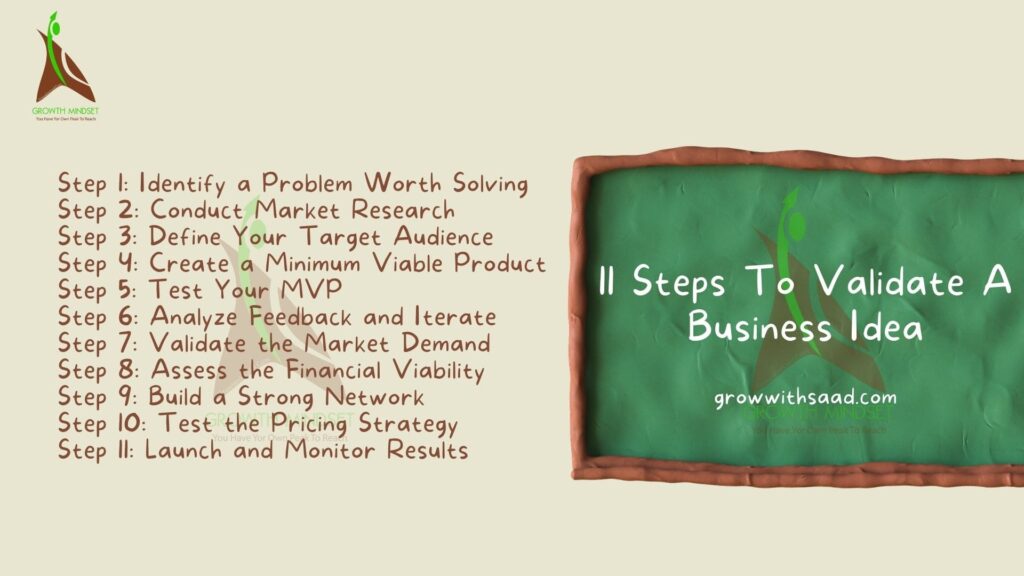Are you ready to turn your brilliant business idea into a reality in 2024? The first step towards success is to validate a business idea and ensure its viability in the market.

In this fast-paced and ever-evolving world, it is crucial to stay ahead of the curve and make informed decisions. So, let’s embark on a journey of inspiration and discovery as we explore the essential steps to validate your business idea in 2024.
Get ready to unleash your entrepreneurial spirit and pave the way for a prosperous future!
Post Contents
What is Business Idea Validation?
In the world of entrepreneurship, having a brilliant business idea is just the beginning. The real challenge lies in validating that idea to ensure its feasibility and potential for success. Business idea validation is the process of testing and gathering evidence to determine whether a business concept has the potential to be profitable and sustainable.
Need To Validate A Business Idea
You might be wondering: Why do I need to validate a business idea? Tell me, are you someone who constantly comes up with brilliant business ideas? Do you dream of turning these ideas into successful ventures?

Well, it’s time to take that leap of faith and validate your business idea! Here is how you should proceed:
Minimize Risks and Maximize Opportunities
Validating your business idea allows you to identify potential risks and challenges early on. By conducting market research, analyzing competitors, and gathering feedback from potential customers, you can gain valuable insights into the market demand and competition landscape.
This knowledge enables you to make informed decisions, minimize risks, and seize opportunities that align with your business goals.
Save Time and Resources
Imagine investing months or even years into developing a product or service, only to realize later that there is no market demand for it. By validating your business idea, you can avoid wasting precious time, energy, and resources on ideas that may not resonate with your target audience.
This process allows you to focus your efforts on ideas that have a higher likelihood of success, ensuring efficient use of your limited resources.
Enhance Customer Understanding
Validating your business idea involves interacting with potential customers and gathering their feedback. This direct engagement provides you with a deeper understanding of your target audience’s needs, preferences, and pain points.
By empathizing with your customers and tailoring your product or service to meet their specific requirements, you can create a solution that truly resonates with them. This customer-centric approach increases the chances of attracting and retaining loyal customers.
Gain Investor Confidence
If you plan to seek external funding for your business, validating your idea is crucial to gaining investor confidence. Investors are more likely to support ventures that have a solid foundation and demonstrate market potential.
By presenting comprehensive market research, customer feedback, and a validated business model, you can instill trust in potential investors and increase your chances of securing the necessary funding to turn your idea into a reality.
Adapt and Pivot
Business idea validation allows you to test your assumptions and hypotheses in a controlled environment. If the results indicate that your initial idea needs adjustments, you can pivot and make the necessary changes before fully launching your business.
This flexibility is essential in today’s dynamic market, where adaptability is often the key to survival and long-term success. Validating your idea empowers you to make informed decisions and iterate your concept to better align with market needs.
11 Steps To Validate A Business Idea
Have you ever had a brilliant business idea that seemed like a game-changer, but you weren’t sure if it would work? We’ve all been there. We need to validate a business idea before diving headfirst into entrepreneurship. It requires a thoughtful approach that involves careful research and analysis.

In this blog post, we will guide you through 11 essential steps to validate your business idea, ensuring that you are on the right track toward success. So, let’s get started and turn your idea into a thriving reality!
Step 1: Identify a Problem Worth Solving
At its core, problem-solving is an art form that enables us to transform challenges into opportunities. It is the driving force behind every great invention, groundbreaking business, and life-changing idea. By emphasizing the significance of finding a problem that truly needs a solution, we open ourselves up to a world of untapped potential.
To truly embrace the significance of finding a problem in need of a solution, we must think beyond the obvious. It is easy to get caught up in the routine of daily life, overlooking the unique opportunities that lie beneath the surface.
By encouraging ourselves to think creatively, we can identify problems that others may have overlooked, leading us to innovative and groundbreaking solutions.
In a world saturated with ideas, standing out from the crowd is crucial. By identifying unique opportunities, we set ourselves apart, paving the way for success.
When we find a problem that resonates with us and develop a solution that is both innovative and effective, we create a niche for ourselves in the market. Uniqueness breeds success, and by embracing the significance of finding a problem that truly needs a solution, we position ourselves for greatness.
Step 2: Conduct Market Research
In the fast-paced and ever-evolving world of business, staying ahead of the competition is crucial. To achieve this, entrepreneurs and marketers need to possess a deep understanding of their target market and competitors.
This is where thorough research plays a pivotal role. By investing time and effort into researching the target market and competitors, businesses can gain valuable insights that can shape their strategies and lead them toward success.
Researching the target market is like embarking on a quest to discover hidden treasures. It enables businesses to identify their ideal customers, understand their needs, and develop products or services that cater to those needs.
By delving into the demographics, psychographics, and behavior patterns of potential customers, businesses can tailor their offerings to match their preferences.
Knowing your target market inside out allows you to create targeted marketing campaigns that resonate with your audience. It helps you speak their language, address their pain points, and build a strong connection. This level of personalization not only increases the chances of converting leads into customers but also fosters brand loyalty and advocacy.
Market research allows you to analyze the strengths and weaknesses of your competitors, identify gaps in the market, and develop unique selling propositions. Understanding their pricing strategies, marketing tactics, and customer service approaches can help you differentiate your brand and offer superior value to customers.
Step 3: Define Your Target Audience
In today’s competitive business landscape, understanding your target audience is more crucial than ever before. Gone are the days of casting a wide net and hoping to catch a few customers.
Instead, successful businesses are focusing on narrowing down their target audience to create a more personalized and effective marketing strategy. But why is this so significant?
First, by narrowing down your target audience, you can ensure that your marketing efforts are relevant and tailored to the specific needs and preferences of your customers. This means that your message will resonate more strongly with the people who are most likely to become your loyal customers.
When your marketing is relevant, it becomes much more effective at capturing attention and driving conversions.
Second, every business has limited resources, whether it’s time, money, or manpower. By narrowing down your target audience, you can allocate your resources more efficiently. Rather than wasting time and money on reaching people who are unlikely to be interested in your product or service, you can focus your efforts on those who are most likely to convert.
This allows you to maximize your return on investment and make the most of your available resources.
Third, creating buyer personas is an essential step in narrowing down your target audience. These personas are fictional representations of your ideal customers, based on real data and market research.
By developing detailed buyer personas, you can gain a deeper understanding of your customers’ pain points, motivations, and preferences. This understanding will enable you to create more targeted and effective marketing campaigns, as well as develop products and services that truly meet your customers’ needs.
Step 4: Create a Minimum Viable Product (MVP)
It’s time to take action and develop your own simple prototype. Here are a few reasons why you should be inspired to do so:
- Market Validation: By creating an MVP, you can test your business idea in the real world and validate its potential. It allows you to gather feedback from early adopters and make necessary adjustments before investing heavily in development.
- Cost and Time Efficiency: Developing a full-scale product can be time-consuming and expensive. By focusing on the core features and functionalities, an MVP helps you save both time and money. It allows you to iterate quickly and make improvements based on user feedback, ensuring you’re on the right track.
- Risk Mitigation: Launching a product without proper validation can be risky. By starting with an MVP, you minimize the risk of failure. You gain insights into customer preferences, market demand, and potential challenges early on, enabling you to pivot or refine your idea accordingly.
- Early Customer Engagement: An MVP allows you to involve your target audience from the very beginning. By engaging with early adopters, you can build a community around your product, generate buzz, and create a loyal customer base even before the official launch.
- Continuous Improvement: Developing an MVP is not a one-time event; it’s an ongoing process. By constantly iterating and improving your prototype based on user feedback, you can create a product that truly meets your customers’ needs. This iterative approach ensures that you’re always one step ahead of the competition and delivering value to your users.
Step 5: Test Your MVP
As an entrepreneur or product developer, you have poured your heart and soul into creating your Minimum Viable Product (MVP). You have meticulously designed every feature, ensuring that it addresses a specific pain point in the market.
But how do you know if your MVP is truly meeting the needs of your target audience? The answer lies in gathering feedback and making the necessary improvements.
One of the most effective ways to gather feedback on your MVP is through surveys. Surveys allow you to reach a large number of potential users and gather valuable insights about their preferences, pain points, and overall satisfaction with your product.
By asking the right questions, you can uncover hidden opportunities for improvement and gain a deeper understanding of your target audience.
Another method to test your MVP is through focus groups. These small, carefully selected groups of individuals can provide you with qualitative feedback that goes beyond what a survey can offer.
Focus groups allow you to observe how users interact with your product, identify any usability issues, and gain insights into their emotional responses. This firsthand feedback can be invaluable in refining your MVP and making it even more user-friendly.
Lastly, beta testing is an excellent way to gather feedback from real users who are willing to test your product in its early stages. By releasing your MVP to a select group of beta testers, you can observe how they use it, identify any bugs or glitches, and gather feedback on its overall performance.
This real-world testing allows you to make necessary improvements before launching your product to a wider audience.
Step 6: Analyze Feedback and Iterate
Feedback is a mirror that reflects the reality of our business. It provides valuable insights into what works and what needs improvement. However, to truly harness the power of feedback, we must approach it with objectivity. By setting aside personal biases and emotions, we can extract meaningful data that will shape our business’s future.
Objective analysis of feedback allows us to identify patterns, trends, and areas of improvement that may have otherwise gone unnoticed. It helps us understand our customers’ needs and preferences, enabling us to tailor our products or services accordingly.
Moreover, objective feedback analysis helps us identify potential roadblocks and challenges, allowing us to proactively address them before they hinder our progress.
Once we embrace the importance of analyzing feedback objectively, we open ourselves up to a world of possibilities. Feedback becomes a catalyst for growth, propelling us towards innovation and refinement.
Step 7: Validate the Market Demand
In the fast-paced world of business, it’s easy to get caught up in the excitement of a new product or service idea. The thrill of innovation and the desire to bring something unique to the market can be overwhelming. However, it’s crucial to take a step back and evaluate the significance of validating market demand before investing heavily.
Validating market demand is the process of gauging customer interest and ensuring that there is a demand for your product or service before diving headfirst into production or development. It’s a strategic approach that can save you from potential financial losses and wasted resources.
By following these steps, you can inspire yourself to validate market demand effectively:
- Research and Identify Your Target Market: Understand your target audience’s needs, preferences, and pain points. Conduct market research, analyze competitors, and identify gaps in the market that your product or service can fill.
- Create a compelling pre-order or pre-sale campaign: Craft a captivating marketing campaign that highlights the unique features and benefits of your offering. Use persuasive language, visuals, and storytelling techniques to inspire potential customers to take action.
- Leverage Social Media and Influencers: Utilize social media platforms to create buzz around your pre-order or pre-sale campaign. Collaborate with influencers or industry experts who align with your brand values to amplify your message and reach a wider audience.
- Offer Incentives and Exclusive Benefits: Encourage potential customers to pre-order or pre-purchase by offering incentives such as discounts, limited edition items, or exclusive access to additional features. This creates a sense of urgency and exclusivity, driving customer interest.
- Gather Feedback and Analyze Data: Throughout the pre-order or pre-sale phase, actively collect feedback from customers. Monitor sales data, customer inquiries, and engagement metrics to gain insights into market demand. Use this data to refine your offering and make informed decisions.
Step 8: Assess the Financial Viability
Starting a new business venture is an exciting and invigorating experience. It’s a chance to turn your dreams into reality and make a meaningful impact on the world. However, amidst all the enthusiasm, it is crucial to take a step back and assess the financial viability of your business idea.
A detailed financial plan is the backbone of any successful business. It provides a roadmap for your financial goals and helps you make informed decisions. By creating a comprehensive plan, you can identify potential revenue streams, estimate expenses, and determine the profitability of your business idea.
Consider the worst-case scenarios and create contingency plans. This will help you navigate unforeseen circumstances and ensure the financial stability of your business. Remember, being prepared is the key to success, and a detailed financial plan plays a crucial role in this preparation.
And remember, assessing the financial viability of your business idea is not a one-time task. It’s an ongoing process that requires continuous monitoring and adjustment.
As your business evolves, so will your financial plan. Regularly review and update your plan to ensure that it remains aligned with your goals and reflects the current market conditions.
Step 9: Build a Strong Network
We often find ourselves yearning for guidance and support from those who have already walked the path we aspire to tread. This is where building a network of mentors, advisors, and potential customers can truly work wonders in propelling us toward success.
Mentors: The Beacons of Wisdom
Imagine having a personal guide—someone who has already faced the challenges you’re currently encountering and emerged victorious. Mentors are like beacons of wisdom, offering valuable insights and advice based on their own experiences. They possess a wealth of knowledge and can help you navigate through the complexities of your industry.
By building a network of mentors, you gain access to a diverse range of perspectives and expertise. They can provide you with invaluable guidance, helping you avoid common pitfalls and make informed decisions. Their wisdom can save you time, effort, and resources, enabling you to progress faster and more efficiently toward your goals.
And many a time, innovation often thrives in collaboration and open dialogue. Advisors play a crucial role in this process, acting as sounding boards for your ideas and providing constructive criticism. They bring fresh perspectives to the table, challenging your assumptions and pushing you to think outside the box.
By surrounding yourself with advisors, you create an environment conducive to growth and innovation. Their feedback can help you refine your ideas, identify potential blind spots, and uncover new opportunities. Their expertise can be instrumental in shaping your strategies and ensuring you stay ahead of the curve in your industry.
Also, customers are the lifeblood of any business. Building a network of potential customers can provide you with a direct line of communication with your target market. By engaging with them early on, you can gain valuable insights into their needs, preferences, and pain points.
This direct connection with potential customers allows you to tailor your products or services to meet their specific demands. It enables you to build strong relationships, establish trust, and create a loyal customer base. By understanding your customers intimately, you can position yourself as the go-to solution provider in your industry, setting the stage for long-term success.
Step 10: Test the Pricing Strategy
Pricing is a critical aspect of any business, as it directly impacts profitability and customer perception. Determining the right price for a product or service can be a challenging task, but it is essential for long-term success.
One effective approach to finding the optimal pricing strategy is to test different options. In this blog post, we will discuss the significance of testing various pricing strategies and encourage readers to consider factors such as production costs, competition, and perceived value.
- Maximizing Profitability
Testing different pricing strategies allows businesses to identify the price point that maximizes profitability. By experimenting with various price levels, companies can analyze the impact on sales volume and revenue.
It is crucial to strike a balance between setting a price that covers production costs and generating enough profit to sustain and grow the business. Testing different pricing options enables businesses to fine-tune their strategies and find the sweet spot that ensures maximum profitability.
- Understanding Production Costs
When testing different pricing strategies, it is essential to consider production costs. These costs include raw materials, labor, overhead expenses, and any other expenses directly related to the creation of the product or service.
By thoroughly understanding production costs, businesses can avoid setting prices that result in losses or unsustainable profit margins. Testing different pricing options allows companies to align their prices with the actual costs involved, ensuring a healthy bottom line.
- Analyzing Competition
Competition plays a significant role in pricing decisions. Testing different pricing strategies helps businesses gauge how their prices compare to those of their competitors. By monitoring customer response and market dynamics, companies can adjust their prices to gain a competitive edge.
It is crucial to strike a balance between offering a competitive price and maintaining profitability. Testing different pricing strategies allows businesses to find the optimal position within the market and attract customers while remaining financially viable.
- Evaluating Perceived Value
Perceived value is the worth that customers assign to a product or service based on their perception of its benefits and quality. Testing different pricing strategies helps businesses understand how customers perceive the value of their offerings at various price points. By experimenting with different prices, companies can gauge customer reactions and identify the price that maximizes perceived value.
Customers are more likely to purchase a product or service if they believe its benefits outweigh the price they pay. Testing different pricing strategies enables businesses to align their prices with perceived value, increasing customer satisfaction and loyalty.
Step 11: Launch and Monitor Results
Believe in yourself and your abilities. You have a unique vision and perspective that can change the world. By launching your business idea, you not only inspire yourself but also inspire others to follow their dreams. Your courage and determination will serve as a beacon of hope for those who are still hesitant to take the leap.
Launching a business is not just about the end goal; it’s about the journey. Embrace the challenges and setbacks that come your way, as they will only make you stronger and more resilient. Every obstacle you overcome is a lesson learned and a step closer to success.
Once you’ve launched your business, closely monitor the results and make necessary adjustments along the way. Keep a close eye on your customers’ feedback, market trends, and competitors. Adaptability is the key to staying ahead in the ever-evolving business landscape.
Remember to celebrate every small win along the way. Building a business is a marathon, not a sprint. Acknowledge and appreciate the progress you make, no matter how small it may seem. These small wins will fuel your motivation and keep you going during challenging times.
And don’t be afraid to seek support and guidance from mentors, industry experts, and fellow entrepreneurs. Surround yourself with a network of like-minded individuals who can provide valuable insights and advice. Their experiences can help you navigate through the ups and downs of entrepreneurship.
Remember, passion and persistence are the driving forces behind every successful business. Stay true to your vision and keep pushing forward, even when faced with obstacles. Remember, Rome wasn’t built in a day, and neither will your business. Stay focused, stay determined, and success will follow.
Conclusion
In conclusion, if you have a brilliant business idea, it is crucial to validate its viability in the market before diving into execution. Taking the time to thoroughly analyze and research your idea will increase your chances of success in 2024. By approaching this process with a thoughtful and strategic mindset, you can ensure that your business idea has the potential to become a reality and thrive in the competitive market.

